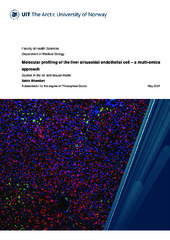| dc.contributor.advisor | Sørensen, Karen Kristine | |
| dc.contributor.author | Bhandari, Sabin | |
| dc.date.accessioned | 2021-08-03T08:56:15Z | |
| dc.date.available | 2021-08-03T08:56:15Z | |
| dc.date.issued | 2021-08-20 | |
| dc.description.abstract | The endothelium is the innermost cell layer of blood vessels and has a key role in maintaining vascular homeostasis. Beside the general role to prevent blood coagulation and regulate blood flow, endothelial cells of different vascular beds show tissue specific specializations. This thesis focuses on a unique endothelial cell with immune-like properties, namely the liver sinusoidal endothelial cell (LSEC) that make up the perforated wall of the hepatic sinusoids. LSECs, together with liver-resident macrophages (Kupffer cells) constitute an efficient scavenger cell system for removal of microbial products, viruses, and waste macromolecules from blood. However, the spatial co-localization of LSECs and Kupffer cells in the sinusoids, species differences in cell marker expression, and variation in cell culture systems between laboratories have led to confusion around the LSEC phenotype. In addition, LSECs are challenging cells to study as they rapidly lose core functions in vitro. In this thesis a multi-omics approach was used to resolve some of the discrepancies in the literature about the LSEC phenotype.
In the first part of the study, mRNA sequencing and label-free proteomics were used to characterize and compare the transcriptomes and proteomes of rat LSECs and KCs at gene, protein, and functional levels. The findings support complementary and partly overlapping scavenging and immune functions of the two cells. Both cells expressed high levels of scavenger receptors and C-type lectins recapitulating their high endocytic activity in vivo. Some of these receptors were equally expressed, suggesting functional similitudes of LSECs and Kupffer cells, while several were cell-type specific. Many immune regulatory factors were also differentially expressed in LSECs and KCs, illustrating the complex cytokine milieu of the hepatic sinusoids.
In the second part of the study, tandem mass tag (TMT)-based quantitative proteomics was used to reveal culture-induced changes in rat and mouse LSECs and effects of pro- and anti-inflammatory stimuli on the cells. In both animal models, LSEC showed a rapid shift in metabolism, downregulation of endocytosis receptors, and gain of proinflammatory functions in primary culture. The use of the anti-inflammatory drug dexamethasone repressed LSEC activation, and improved cell survival in vitro, and the study presents a detailed overview of biological processes and pathways affected by dexamethasone in the cells. | en_US |
| dc.description.doctoraltype | ph.d. | en_US |
| dc.description.popularabstract | The endothelium is the innermost cell layer of blood vessels. Besides the general role to prevent blood coagulation and regulate blood flow, endothelial cells show tissue-specific specializations. This thesis describes a unique endothelial cell with immune-like properties, namely the liver sinusoidal endothelial cell (LSEC). LSECs are important scavenger cells eliminating microbial products, viruses, and waste substances from the blood. In his thesis, Bhandari used a multi-omics profiling approach to reveal the molecular phenotype of rat and mouse LSECs, two model species in medical research. Bhandari studied LSECs under various conditions and compared the cells with another important cell in host defense, namely liver macrophages. His findings revealed complementary and partly overlapping scavenging and immune functions of the two cells. This thesis also provides a detailed overview of the effects of the important anti-inflammatory drug dexamethasone on LSEC protein expression and functions. | en_US |
| dc.description.sponsorship | This work was supported by the University of Tromsø (UiT) - The Arctic University of Norway | en_US |
| dc.identifier.uri | https://hdl.handle.net/10037/21896 | |
| dc.language.iso | eng | en_US |
| dc.publisher | UiT The Arctic University of Norway | en_US |
| dc.publisher | UiT Norges arktiske universitet | en_US |
| dc.relation.haspart | <p>Paper I: Bhandari, S., Li, R., Simon-Santamaria, J., McCourt, P., Johansen, S.D., Smedsrød, B., Martinez, I.Z. & Sørensen, K.K. (2020). Transcriptome and proteome profiling reveal complementary scavenger and immune features of rat liver sinusoidal endothelial cells and liver macrophages. <i>BMC molecular and cell biology, 21</i>(1), 85. Also available in Munin at <a href=https://hdl.handle.net/10037/19952>https://hdl.handle.net/10037/19952</a>.
<p>Paper II: Li, R., Bhandari, S., Martinez, I., Bruun, J.A., Urbarova, I., Smedsrød, B., Simon-Santamaria, J. & Sørensen, K.K. Changes in the proteome and secretome of rat liver sinusoidal endothelial cells during early primary culture and effects of dexamethasone. (Manuscript).
<p>Paper III: Bhandari, S., Kyrrestad, I., Simon-Santamaria, J., Li, R., Smedsrød, B. & Sørensen, K.K. Mouse liver sinusoidal endothelial cell responses to the glucocorticoid receptor agonist dexamethasone in vitro. (Manuscript). | en_US |
| dc.rights.accessRights | openAccess | en_US |
| dc.rights.holder | Copyright 2021 The Author(s) | |
| dc.rights.uri | https://creativecommons.org/licenses/by-nc-sa/4.0 | en_US |
| dc.rights | Attribution-NonCommercial-ShareAlike 4.0 International (CC BY-NC-SA 4.0) | en_US |
| dc.subject | VDP::Technology: 500::Biotechnology: 590 | en_US |
| dc.subject | VDP::Teknologi: 500::Bioteknologi: 590 | en_US |
| dc.subject | VDP::Technology: 500::Medical technology: 620 | en_US |
| dc.subject | VDP::Teknologi: 500::Medisinsk teknologi: 620 | en_US |
| dc.subject | VDP::Medical disciplines: 700::Basic medical, dental and veterinary science disciplines: 710::Medical molecular biology: 711 | en_US |
| dc.subject | VDP::Medisinske Fag: 700::Basale medisinske, odontologiske og veterinærmedisinske fag: 710::Medisinsk molekylærbiologi: 711 | en_US |
| dc.title | Molecular profiling of the liver sinusoidal endothelial cell – a multi-omics approach | en_US |
| dc.type | Doctoral thesis | en_US |
| dc.type | Doktorgradsavhandling | en_US |


 English
English norsk
norsk
